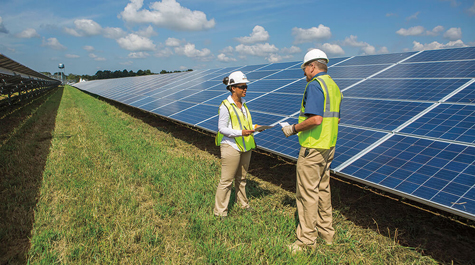William & Mary signs solar power agreement with Dominion Energy
W&M to source highest percentage of renewable energy of any public Virginia university
William & Mary has signed a power purchase agreement with Dominion Energy that will source nearly 50% of the university’s electricity from renewable energy.
At that rate, W&M will be sourcing a greater percentage of renewable energy than any other public university in the state. With electricity being the largest part of W&M’s carbon footprint, the agreement gets the university one step closer to becoming carbon neutral by 2030 — a goal it announced last fall in partnership with the University of Virginia.
“Management of energy both through our use and by source is an essential step in meeting the university’s 2030 carbon neutral goal,” said Sam Jones, senior vice president for finance and administration. “Partnering with Dominion Energy makes good environmental as well as business sense as we move toward this goal.”
The 20 MWAC project was developed by Strata Solar, which will also install the solar facility infrastructure on a farm located in nearby James City County.
Initial work on the project is expected to begin within the next few months, according to Farley Hunter, associate director of utilities, who has been working closely with Dominion Energy on the agreement. The production of solar energy at the farm will likely begin in 2021.
“We are proud to support William & Mary’s efforts to reduce their carbon footprint by powering their operations with renewable energy,” said Emil Avram, vice president of business development for Dominion Energy. “Adding cleaner energy to the grid benefits everyone, and partnerships like this help expand the development of clean energy by driving the market for renewables here in Virginia.”
William & Mary expects the 20-year contract will begin to save the university money after about six years.
“It is a great benefit to the W&M carbon neutrality goal, but it also makes business sense,” said Calandra Waters Lake, director of sustainability at W&M. “By knowing how much we will be paying for electricity over the next 20 years, our institution can plan appropriately. As the price of electricity fluctuates, and likely goes up, then there is also a chance for W&M to save money.”
Two demonstration solar projects are planned on campus for educational purposes. It has been difficult to find real estate to install them on a large scale, said Waters Lake.
“It's been difficult to put in on-site solar of any substantive size that would reflect the commitment that we really want to make to green power,” said Hunter.
The decision to explore power purchase agreements was part of the university’s Sustainability Plan, which was announced in November 2018. Facilities Management has done “an outstanding job” of pursuing that goal and collaborating with Dominion Energy to identify the right project and set appropriate terms, said Waters Lake.
“We worked hard to get here,” said Hunter. “But it's a substantial component of our evolving sustainability plan.”
The university is currently working on a Climate Action Plan, which will include additional steps to bring the university closer to its 2030 carbon neutrality goal.
W&M and Dominion Energy are discussing ways in which this effort can be used to benefit educational opportunities.
“In alignment with the mission of the university, we want this to be a teaching and learning opportunity,” said Waters Lake. “By connecting the project to curriculum and research, it has a broader impact beyond moving our campus toward carbon neutrality, it provides experiences that influence the decision-makers and problem-solvers of tomorrow.” Skip to main content
Skip to main content

